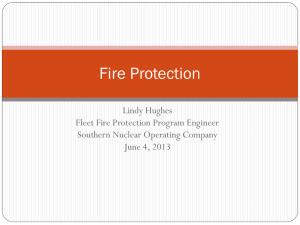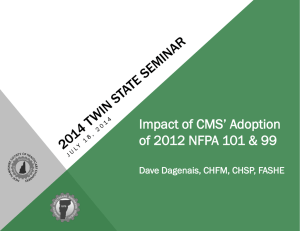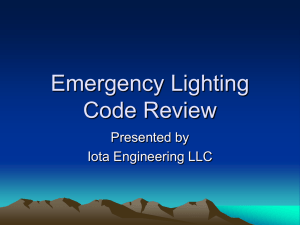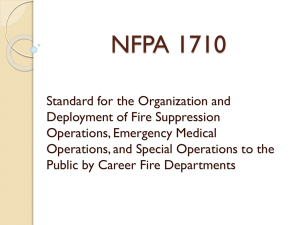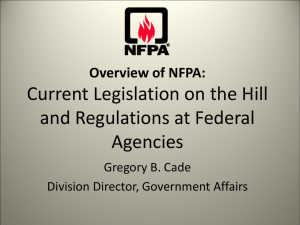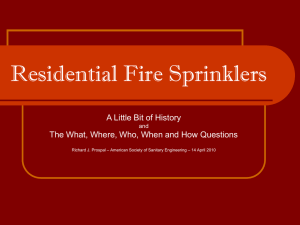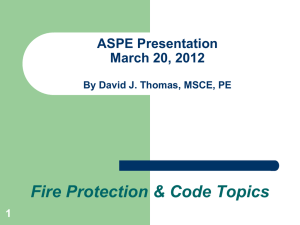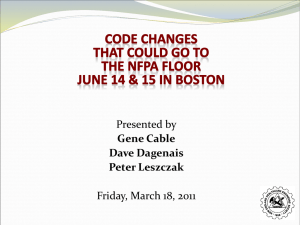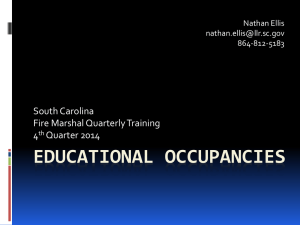top 10k-tags cited in nursing homes in ffy07 k144
advertisement
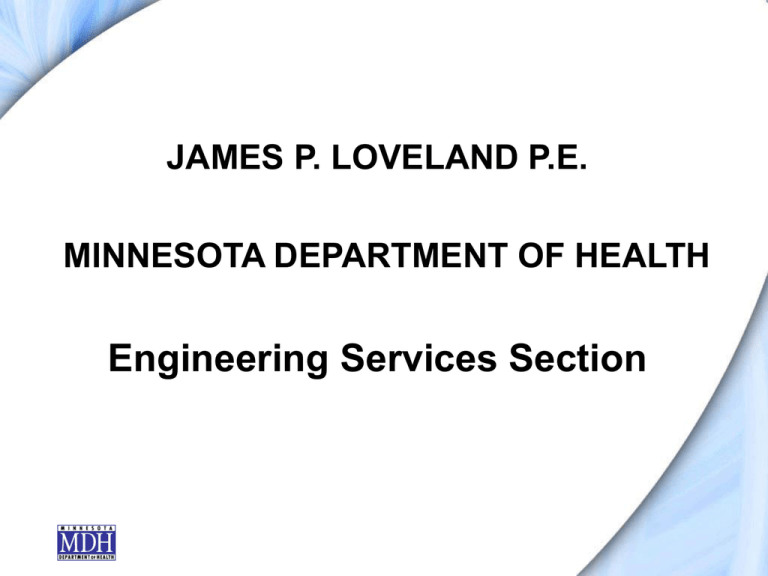
JAMES P. LOVELAND P.E. MINNESOTA DEPARTMENT OF HEALTH Engineering Services Section FEDERAL MONITORING SURVEYS 2007 2008 2009 No. of FMSs 20 20 20 No. of Deficiencies 332 252 173 Defs/Survey 16.6 12.6 8.65 % Drop ---- 24% 33% FEDERAL MONITORING SURVEYS And the winner is ….. K144: GenSet inspection and testing (3rd year at #1 or #2) Runner up ….. K052: Fire alarm testing (3rd year at #1 or #2) K144 – GENERATOR INSTALLATION, TESTING, AND MAINTENANCE Type I and Type II EESs must use a Level I generator in accordance with NFPA 110 Level 1 generators must be inspected weekly and tested under load monthly K144 – GENERATOR INSTALLATION, TESTING, AND MAINTENANCE (cont.) Weekly inspections As specified by the manufacturer If manufacturer weekly inspection requirements are unknown, the maintenance schedule in NFPA 110, Appendix A, can be used K144 – GENERATOR INSTALLATION, TESTING, AND MAINTENANCE (cont.) Weekly inspections and monthly tests must be completely documented Monthly load testing must meet one of the following minimum requirements for 30 minutes K144 – GENERATOR INSTALLATION, TESTING, AND MAINTENANCE (cont.) At not less than 30% of nameplate rating With a load that maintains the minimum exhaust temperature as recommended by the manufacturer K144 – COMMON PROBLEMS Generator lacks a remote annunciator panel This requirement has been in existence in a less comprehensive form since the 1960s K144 – COMMON PROBLEMS (cont.) Older installations need a minimum panel Audible trouble indicator Visual indicators for trouble and generator operation Storage in generator enclosures Indoor generators lack battery-powered task illumination K144 – COMMON PROBLEMS (cont.) Natural gas fueled generator lacks proof that the fuel source is reliable (cited at K146) Test documentation problems Visual inspections are not described K144 – COMMON PROBLEMS (cont.) Must be itemized each week Must be a document that shows all weekly visual inspections that can be referenced during tests and documentation review K144 – COMMON PROBLEMS (cont.) Monthly load tests not completely documented Measurements taken from one leg only on a 3-phase generator Comment that test was more than 30% of nameplate rating with no supporting documentation K146 – LETTER OF RELIABILITY Reliability of natural gas fuel source can be proven with a letter from natural gas vendor that contains the following A statement that the fuel source is reasonably reliable K146 – LETTER OF RELIABILITY (cont.) Description supporting the reasonable reliability assertion A statement of the low likelihood of an interruption K146 – LETTER OF RELIABILITY (cont.) Description supporting the low interruption assertion Signature of technical personnel An S&C Bulletin has been drafted by CMSCO addressing this issue K146 – LETTER OF RELIABILITY (cont.) This S&C Bulletin includes the elements detailed in the previous slide The intent of the S&C Bulletin is to assure uniform enforcement of these requirements across the United States K052 – FIRE ALARM SYSTEM TESTING AND MAINTENANCE Testing and maintenance of the fire alarm system must be conducted at the proper frequency in accordance with NFPA 72, Tables 7-3.1 and 7-3.2 Different components have different test and inspection frequencies K052 – FIRE ALARM SYSTEM TESTING AND MAINTENANCE (cont.) Test frequencies for all systems Quarterly testing of the off-premises transmission equipment Annual test of the entire fire alarm system K052 – FIRE ALARM SYSTEM TESTING AND MAINTENANCE (cont.) Quarterly testing Off-premises transmission equipment This test can be done as part of the fire drills if receipt of the fire alarm signal is verified and documented K052 – FIRE ALARM SYSTEM TESTING AND MAINTENANCE (cont.) Annual testing Must be conducted in accordance with NFPA 72, Chapter 7 and documented in accordance with NFPA 72, Figure 7-5.2.2 K052 – FIRE ALARM SYSTEM TESTING AND MAINTENANCE (cont.) Vendors are not required to use NFPA form, however; all information in the NFPA form must be included in the vendor created form Items that are not applicable must be marked as such (N/A) and not omitted from the form ISSUES DISCUSSED AT LIFE SAFETY CODE MANAGERS MEETING IN CHICAGO (April 14 – 15, 2010) ADOPTION OF A MORE CURRENT EDITION OF NATIONAL FIRE PROTECTION ASSOCIATION (NFPA) STANDARD 101 (LIFE SAFETY CODE) CMS staff indicated that they are considering adoption of the 2012 edition of the Life Safety Code Adoption would occur in 2014 or later INTERIOR FINISHES NFPA TIA (Temporary Interim Amendment) 00-2 amends Section 10.2 of National Fire Protection Association (NFPA) Standard 101 (Life Safety Code, 2000 edition) Exception No. 2 has been added to 10.2.1 INTERIOR FINISHES (cont.) The exception reads: “Approved existing installations of materials applied directly to the surface of walls and ceilings in a total thickness of less than 1/28 in. (0.9 mm) shall be permitted to remain in use and the provisions of 10.2.2 through 10.2.3.5.3 shall not apply.” Effective March 24, 2010 WHAT DOES THIS MEAN TO US? CMS staff indicated that it would take approximately 30 months to adopt this new TIA If you have a SINGLE LAYER of wall paper installed with no documentation, and you want to maintain this wall paper, it is recommended that you determine the thickness of the wall paper (use a micrometer) WHAT DOES THIS MEAN TO US? A waiver for K014 and/or K015 may be possible with proof of thickness (pending adoption of the TIA) FIRE WATCH POLICY Reference NFPA 101 (00), 9.6.1.8 and 9.7.6.1 It is expected that a facility will implement a fire watch if the automatic fire alarm system or automatic sprinkler system is out of service for more than four (4) hours FIRE WATCH POLICY (cont.) The written policy must indicate that the fire watch be “continuous” A written policy is required to address either of these systems being out of service FIRE WATCH POLICY (cont.) It was verified that “continuous” means that the fire watch person(s) are not permitted to perform any other duties while they are assigned fire watch duties A detailed explanation of the fire watch policy is included in the Life Safety Code Documentation Project GAS-FIRED FIREPLACES Reference NFPA 101 (00), 18/19.5.2.2 Nothing new on this issue although MDH and SFMD have anecdotal indication that CMS may be willing to view this equipment as a heating device GAS-FIRED FIREPLACES (cont.) Good article in the January/February 2010 edition of the NFPA Journal A strong effort is being made to revise the 2012 edition of the Life Safety Code to allow for a more caring and comfortable living environment (commonly referred to as “culture change”) GAS-FIRED FIREPLACES (cont.) Gas-fired fireplaces are mentioned in the referenced article SPRINKLER PROTECTION OF ELEVATOR SHAFTS, HOISTWAYS AND PITS ALL certified nursing homes must be fully sprinkled in accordance with NFPA Standard 13 by Tuesday, August 13, 2013 A facility in Minnesota has proposed using the exception to LSC 18/19.3.5.1 to eliminate sprinklers in the elevator machine room SPRINKLER PROTECTION OF ELEVATOR SHAFTS, HOISTWAYS AND PITS (cont.) Exceptions to NFPA Standard 13, 5-13.6, provide a means to eliminate the sprinklers required in the hoistway and pit CMS made it quite clear that “alternative protection measures” means (to them) an alternate extinguishing method SPRINKLER PROTECTION OF CLOSETS In discussing the sprinkler mandate, CMS staff reiterated the requirements regarding sprinkler protection of closets (reference S&C-05-38) We all know that at least one sprinkler head is required inside a closet SPRINKLER PROTECTION OF CLOSETS (cont.) Of particular interest was a statement regarding evaluation of the location of the sprinkler heads relative to the face of the permanently affixedwardrobe Please assure that you know the radius of the coverage pattern for the sprinkler heads protecting the permanently affixed wardrobes SPRINKLER PROTECTION OF CLOSETS (cont.) If the radius of coverage does not include the entire face of the permanently affixed wardrobe (side to side and top to bottom), the facility may be determined to be partially sprinkled HOW ARE WE DOING?? Of the 385 SNFNF and NF facilities, 72 are partially sprinkled and 13 have no sprinkler protection 300, or 78% of Minnesota’s certified nursing homes and boarding care homes are fully sprinkled PROCEDURE IN CASE OF FIRE Reference NFPA 101 (00), 18/19.7.2.2 CMS staff discussed the requirements for a complying health care occupancy fire safety plan Good examples of this plan are included in the Life Safety Code Documentation Project SO THAT’S WHAT THEY LOOK FOR CMS staff prepared a good PowerPoint presentation that is really an inside look into Form CMS-2786R MDH has requested an electronic copy of the presentation so that the Minnesota Health Care Engineers Association, Care Providers of Minnesota, and Aging Services of Minnesota can post the presentation on their respective web sites
